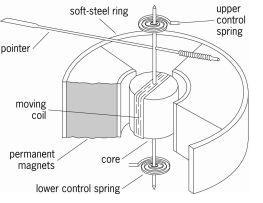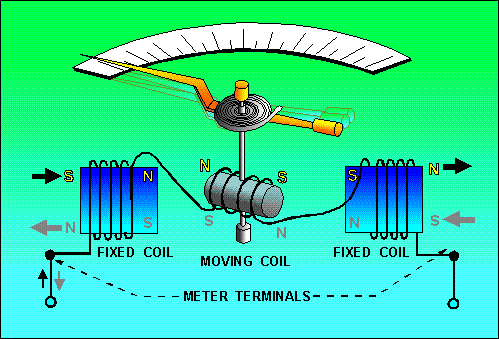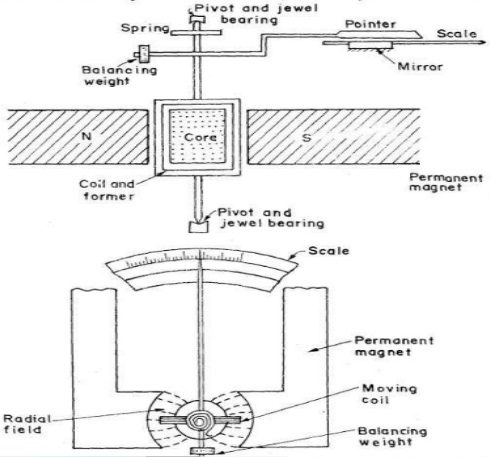Permanent Magnet Moving Coil Instrument (PMMC):
The permanent magnet moving coil instrument is the most accurate type for dC measurements.Working principle of pmmc instrument is the same as that of the d’Arsonval type of galvanometers, the difference being that direct reading instrument is provided with a pointer and a scale.
Construction of pmmc instruments:
The general constructional features of pmmc instrument are shown in below figure:
Moving coil: The moving coil is wound with many turns of enamelled or silk covered copper wire. The coil is mounted on a rectangular aluminium former which is pivoted on jewelled bearings. The coils move freely in the field of a permanent magnet. Most voltmeter coils are wound on metal frames to provide the required electromagnetic damping. Most ammeter coils, however, are wound on non-magnetic formers, because coil turns are effectively shorted by the ammeter shunt. The coil itself,therefore, provide electromagnetic damping.
Magnet systems: There has been considerable development in materials for permanent magnets and therefore, magnet assemblies have undergone a lot of change in the recent past. Old style magnet system consisted of a relatively long U shaped permanent magnets having soft iron pole pieces. The flux densities used in pmmc instruments vary from 0.1 Wb/m2 to 1 Wb/m2.Thus in all small instruments it is possible to use a small coil having small number of turns and hence a reduction in volume is achieved.Alternatively in instruments having a large scale length it is possible to increase the air gap length to accommodate large number of turns.
 The movement of the coil is restricted in the above design. This is because no actual part of the coil is allowed to reach the extreme positions near the pole tips where, there is fringing field.Thus the angular span of scale is restricted to 90 degrees. In order to obtain longer moment of the pointer and a longer swing of the coil a concentric magnet construction is used. Since the magnet is concentric type it produces a radial flux pattern which extends over 250 degrees or more. This type of construction is used for many panel type instruments and some portable instruments.
The movement of the coil is restricted in the above design. This is because no actual part of the coil is allowed to reach the extreme positions near the pole tips where, there is fringing field.Thus the angular span of scale is restricted to 90 degrees. In order to obtain longer moment of the pointer and a longer swing of the coil a concentric magnet construction is used. Since the magnet is concentric type it produces a radial flux pattern which extends over 250 degrees or more. This type of construction is used for many panel type instruments and some portable instruments.
 In recent years, with the development of improved magnetic materials like Alnico, it has become feasible to design a magnetic system in which the magnet itself serves as the core as shown in figure below. The moving coil moves over the magnet. The active sides of the moving coil located in the uniform radial field between pole pieces and steel yoke. This arrangement eliminate the magnetic shunting effect in steel panel construction, where several meters operating side by side may effect each other’s readings. The need for magnetic shielding in the form of iron cases, is also eliminated by core magnet construction.
In recent years, with the development of improved magnetic materials like Alnico, it has become feasible to design a magnetic system in which the magnet itself serves as the core as shown in figure below. The moving coil moves over the magnet. The active sides of the moving coil located in the uniform radial field between pole pieces and steel yoke. This arrangement eliminate the magnetic shunting effect in steel panel construction, where several meters operating side by side may effect each other’s readings. The need for magnetic shielding in the form of iron cases, is also eliminated by core magnet construction.
Control torque: When the coil is supported between two jewel bearings the control torque is provided by two phosphor bronze hair springs. These springs also serve to lead current in and out of the coil. The control torque is provided by the ribbon suspension as shown in figure. This method is comparatively new and is claimed to be advantageous as it eliminates bearing friction.
Damping torque: Damping torque is produced by movement of the aluminium former moving in the magnetic field of the permanent magnet.
Pointer and scale: The pointer is carried by the spindle and moves over a graduated scale. The pointer is of light-weight instruction and apart from those used in some inexpensive instruments has a section over the scale twisted to form a fine blade. This helps to reduce parallax errors in the reading of the scale.
In pmmc instruments such errors may be reduced further by carefully alignment of the pointer scale and its reflection in the mirror adjacent to scale. The weight of the instrument is normally counter balanced by weights situated diametrically opposite and rigidly connected to it.
Torque Equation of PMMC Instrument:
The torque for a permanent magnet moving coil instrument is derived below:
As the deflection is directly proportional to the current passing through the meta meter open (K and G being constants) we get a uniform (linear) scale for the permanent magnet moving coil instrument.In micro-ammeters and low range milli-ammeters upto about 20mA, the entire the entire current to be measured is sent through the moving coil.This is because instrument springs serve as current leads to the moving coil.Their current carrying capacity limits the current which can be safely carried to about 20mA.
Advantages of pmmc instruments:
1.The scale is uniformly divided.
2.The power consumption is very low as 25μW to 200μW.
3.The torque – weight ratio is high which gives a high accuracy. The accuracy is of the order of generally 2% of full scale deflection.
4.A single instrument may be used for many different current and voltage ranges by using different values for shunts and multipliers.
5.Since the operating are large on account of large flux densities which may be as high as 0.5 Wb/m2 the errors due to stray magnetic fields are small.
6. Self shielding magnets make the core magnet mechanism particularly useful in aircraft and Aerospace applications, where multiplicity of instruments must be mounted in close proximity to each other.
Disadvantages of pmmc instruments:
1. These pmmc instruments are useful only for DC. The torque reverses if the current reverses. If the instrument is connected to a.c, the pointer cannot follow the rapid reversals and the deflection corresponds to mean torque, which is zero. Hence these instruments cannot be used for AC.
2. The cost of these pmmc instruments is higher than that of moving iron instruments.

